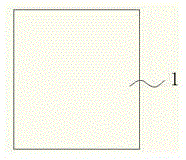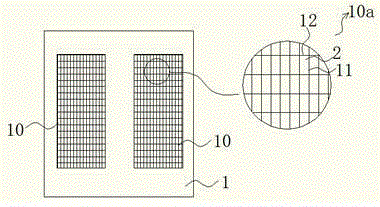Preparation method for ultrathin chip resistor
A technology of chip resistors and resistors, which is applied in the direction of resistors, resistor manufacturing, and manufacturing resistor chips, etc., can solve the problems of easy damage, etc., and achieve the effect of improving product yield, improving production efficiency, and improving easy breakage
- Summary
- Abstract
- Description
- Claims
- Application Information
AI Technical Summary
Problems solved by technology
Method used
Image
Examples
Embodiment 1
[0041] Example 1: A preparation method of an ultra-thin chip resistor, the preparation method comprising the following steps:
[0042] Substrate segmentation: Divide a substrate 1 into two symmetrical areas 10, laser cut several vertical lines 11 and horizontal lines 12 perpendicular to each other on the two areas 10, and several vertical lines 11 and horizontal lines perpendicular to each other The line 12 divides the two areas evenly into several rectangular grids, and each rectangular grid is a resistor unit 2; figure 2 Middle 10a represents the area 10 on the front side of the substrate;
[0043] Step C2: print the conductor layer 20 at each horizontal line 12 on the back side of the substrate 1, see Figure 4 ; image 3 The middle 10b represents the area 10 on the back of the substrate;
[0044] Step C1: Print the conductor layer 21 at each horizontal line 12 on the front side of the substrate 1, see Figure 5 ;
[0045] Step RS: print resistor 22 on the front sid...
Embodiment 2
[0053] Example 2: The difference between this embodiment and Embodiment 1 is that the substrate in this embodiment is a ceramic substrate, the size of the substrate is 60*70mm, and the two symmetrical areas on the substrate are rectangular.
Embodiment 3
[0054] Example 3: The difference between this example and Example 1 is that the thickness of the resistive protective layer in step G1 in this example is 20 ± 10 μm; the thickness of the printed protective layer in step G2 is 20 ± 10 μm; during the electroplating process, The thickness of the nickel plating layer on both sides of each resistor unit is 5.0-6.0 μm; during the electroplating process, the thickness of the zinc plating layer on both sides of each resistor unit is 7.0-8.0 μm. 7.48±1 μm.
PUM
| Property | Measurement | Unit |
|---|---|---|
| Size | aaaaa | aaaaa |
| Thickness | aaaaa | aaaaa |
| Thickness | aaaaa | aaaaa |
Abstract
Description
Claims
Application Information
 Login to View More
Login to View More - R&D
- Intellectual Property
- Life Sciences
- Materials
- Tech Scout
- Unparalleled Data Quality
- Higher Quality Content
- 60% Fewer Hallucinations
Browse by: Latest US Patents, China's latest patents, Technical Efficacy Thesaurus, Application Domain, Technology Topic, Popular Technical Reports.
© 2025 PatSnap. All rights reserved.Legal|Privacy policy|Modern Slavery Act Transparency Statement|Sitemap|About US| Contact US: help@patsnap.com



